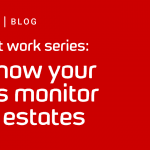DBAs at work #1: The IT services provider DBA
 At Redgate, we regularly chat to IT leaders and experts about the challenges of managing and monitoring their server estates. This series of ‘DBAs at work’ insights is based on some webinars hosted by Grant Fritchey, Microsoft Data Platform MVP, which talked about intensifying data demands and how effective estate monitoring enables DBAs to manage continually evolving environments. This episode features Dennis Heitmann, Database Administrator at Atruvia, which provides information technology services for banking clients in Germany.
At Redgate, we regularly chat to IT leaders and experts about the challenges of managing and monitoring their server estates. This series of ‘DBAs at work’ insights is based on some webinars hosted by Grant Fritchey, Microsoft Data Platform MVP, which talked about intensifying data demands and how effective estate monitoring enables DBAs to manage continually evolving environments. This episode features Dennis Heitmann, Database Administrator at Atruvia, which provides information technology services for banking clients in Germany.
What are you seeing in the way your server estate is changing?
We’ve seen huge growth over the last ten years. When I started working with SQL Server, our company had around 20 instances, and now we have over 600 instances, 7,000 databases and four data centers. I used to have time every day to look at and track every instance but obviously now I don’t, and there’s been a big demand in changing our infrastructure. We’ve invested a lot of time in automation and monitoring to be aware of everything that’s running, even without touching it.
What role does estate monitoring play in your organization?
A couple years ago, I could look at every instance, every day. With the growth of our estates, this isn’t possible any more and we need the ability to be proactive before customers call us. You can’t achieve this if you don’t have a good monitoring environment, so the introduction of SQL Monitor changed my work a lot. We’ve made massive wins on productivity, but on the other side, reactivity as well because stuff like baselining was missed before.
Have you found any surprise benefits with SQL Monitor?
The biggest thing for me, as you introduce the tool set, is that you can drill down on a lot of topics and specifics. Often, you get a call on Monday morning, and they tell you everything broke down for some reason on Saturday at 2pm. We can now look back retrospectively at that data to see exactly what caused the issue and why, while SQL Server offers you only real time data. That was really surprising and makes performance tuning and troubleshooting a lot easier.
I should also mention that the major benefit of SQL Monitor is that it lets you sleep without headaches. The backup alert, for example, is one of my most liked alarms the tool has because, in one view, you can see if the data is backed up across the full estate.
How has the growth of your estate affected your role?
Back when it was just 30 instances, we did almost everything by hand including patching, installing, and updating. Now we’ve introduced automation, you can click a button and a virtual machine gets installed with Windows Server, and SQL server will get installed, configured, and hardened automatically too.
Everything we need to make it run gets added into SQL Monitor with the PowerShell API. With just one click you have a new SQL server that’s fully integrated into the environment. Back when everything was done by hand, this would probably take a whole day. Automation and monitoring are the best assets we have to keep everything running and do more with less.
What are the biggest threats you’re seeing as your estate expands?
I think the most concerning is being blind in your own environment without some monitoring. Now I have good visibility of my estate, and the most stressful thing is keeping up with all the new versions as it feels they come more frequently. But with the automation in place that we have, it’s very easy to keep up to date.
The problem I think everybody has is that team size aren’t changing whereas the infrastructure and estate are rapidly growing. This means you have to manage a lot more with a lot of less people, so if there’s a major issue – for example, the data center breaks down and our emergency plans aren’t working – then we would be in trouble.
Do you think these threats are going to change over the next 12 months?
I don’t see it doing so even over a longer period. Getting new people to increase team size is a huge problem all over the world. If your boss does approve extra headcount, getting the right person with the right skills is a challenge. Finding new talent is a huge problem for us, and yet our estate keeps growing, so you have no choice but to do more with less.
How do you deal with the fact that you’re doing more with less?
You need to be able to change the way you work. A few years ago, I had nothing to do with PowerShell scripting but these days I spend 70% or 80% of my time writing scripts. And that’s a whole different skill set. You need to change not only if you get new technologies, like the cloud but also as your environment grows. It’s an important point and something a lot of DBAs are facing.
Are you seeing any change with more people using Power BI and wanting access to the data?
Yes, but it’s Germany and it’s banking, so we’re paranoid in terms of giving our data away. We keep everything as secure as possible, and the steps you must take to get access to the data are thorough. Our development teams provide a reporting platform which was developed in-house and is as secure as possible, so there’s not much use of Power BI in our company.
What is one takeaway you would like to leave everyone that they can take home and put to work?
Make sure you use all the functionality you have in SQL Monitor, because it provides much more than just alerting or the dashboard view. You can make your own reports, you have overviews about licensing and patching and much more. So really use everything, not only the dashboard.
Look out for other episodes in the DBAs at work series, featuring Grant Fritchey talking to:
- Deborah Thompson, Database Administrator at WestJet
- Kevin Davis, Manager of Database Administration at Tower Loan
If you’re new to SQL Monitor and would like to see how it can help you monitor database performance issues, you can download a fully-functional 14-day free trial, or try our live online demo environment.
Read next
Blog post
DBAs at work #2: The airline DBA
At Redgate, we regularly chat to IT leaders and experts about the challenges of managing and monitoring their server estates. This series of ‘DBAs at work’ insights is based on some webinars hosted by Grant Fritchey, Microsoft Data Platform MVP, which talked about intensifying data demands and how effective estate monitoring enables DBAs to manage
Blog post
DBAs at work #3: The finance company Manager of Database Administration
At Redgate, we regularly chat to IT leaders and experts about the challenges of managing and monitoring their server estates. This series of ‘DBAs at work’ insights is based on some webinars hosted by Grant Fritchey, Microsoft Data Platform MVP, which talked about intensifying data demands and how effective estate monitoring enables DBAs to manage
Tools in this post
Redgate Monitor
Real-time multi-platform performance monitoring, with alerts and diagnostics
